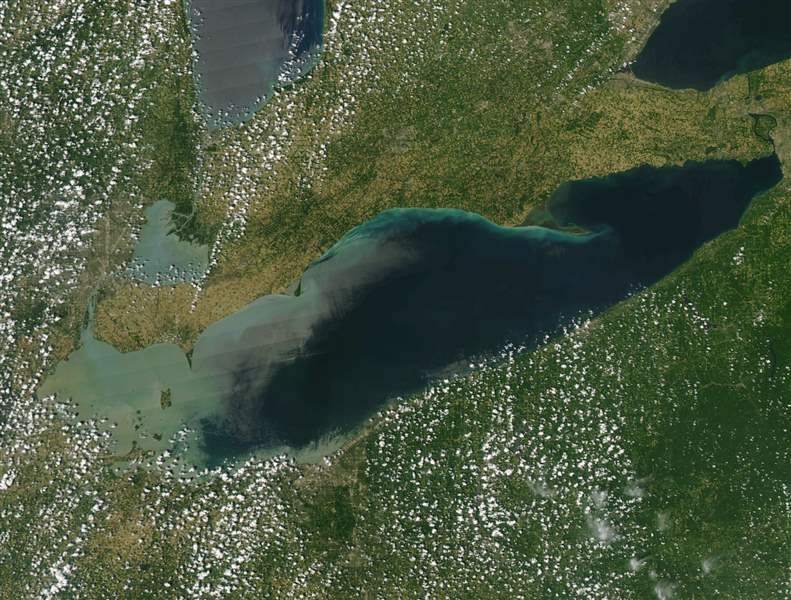
Toxic algae in western Lake Erie makes early arrival because of heat
7/2/2018
July 1 satellite image of Great Lakes Region.
NOAA CoastWatch
Intense heat has caused algal blooms to form in western Lake Erie much sooner than normal.
Though toxin levels are not yet known, officials are issuing their standard advice to stay away from all scums floating on the lake surface.
“Scums are always dangerous and people should avoid them,” Timothy Davis, a Bowling Green State University algae researcher, said.
There are many small blooms now instead of one large one.
They are in the early stages of formation and move around with the wind. One seen along the shoreline of South Bass Island State Park on Sunday was blown out into the open water. By Monday afternoon, the water near that island was clear, Justin Chaffin, Ohio Sea Grant and Ohio State University Stone Laboratory research director, said.
Light, sporadic outbreaks began popping up in various parts of Lake Erie’s western basin the second or third week of June, Tom Bridgeman, University of Toledo algae researcher, said.
These so-called “mini-blooms” have been large enough to be seen via satellite. As temperatures warmed, though — especially after last weekend’s scorcher — they grew faster and became denser.
Scientists said they still don’t know if the scattered, initial blooms are here for the rest of the summer, or if they will dissipate in the coming weeks before the main seasonal bloom becomes established, as they have most other years they’ve formed.
But this much is clear: The lake is about nine days ahead of schedule for producing algae, Mr. Davis said.
Lake Erie has more than 200 types of algae, most of which contribute to the food chain and aren’t dangerous. But the one that garners the most attention, microcystis, is genetically not even algae. It is a blue-green form of toxin-producing bacteria that looks like algae.
It can grow in water as cool as 68 degrees. But it grows exceptionally well when the water temperature is 75 degrees or warmer, Mr. Davis said.
Now, with the region sweltering through a long spell of daytime highs in the high 90s and even nighttime temperatures unusually high, the lake is as warm as bathwater. On Monday afternoon, the lake water temperature recorded by a Stone Lab buoy near Gibraltar Island, across from Put-in-Bay, was a whopping 79.7 degrees, down slightly from Sunday’s 80.2 degrees, Mr. Chaffin said.
He said it’s almost unheard of to have lake water exceed 80 degrees this early in the summer.
Besides South Bass Island, blooms have been spotted recently near Kelleys Island State Park, in North Maumee Bay, and along the shoreline east of Toledo. As far away as Cleveland, the Northeast Ohio Regional Sewer District tweeted Monday about swimming advisories posted at Edgewater State Park and Villa Angela State Park beaches.
The densest bloom found in the latest NASA satellite image, taken at 11:46 a.m. Sunday and distributed Monday by the National Oceanic and Atmospheric Administration, was near Monroe.
Mr. Bridgeman has tracked many of the early season anomalies in the past. The algae typically form in the Toledo area first because the water is shallower and, thus, warmer.
He agrees it’s possible this could be the onset of the main bloom that goes into October — and that there may not be the same break in between that he’s seen other summers.
“We often see a mini-bloom first. But what we're seeing now is more than I've ever seen in June,” Mr. Bridgeman said. “It's persisted for at least two weeks and it's getting bigger. This year could be different.”
Mr. Chaffin said the usual scattered blooms “got a jump start, basically” because of the early heat.
“This could be the start of the real bloom,” he said. “Sometimes, those [mini-blooms] pop up, but they're never this dense.”
For now, there’s no serious threat to Toledo’s water intake, which was smothered by an unusually toxic bloom the first weekend of August, 2014, when the city declared its infamous water crisis. Persistent northeast winds held the bloom over the intake and pushed it under the water column, with a virus in the water causing a heavy number of algal cells to open up and release toxins.
“I haven’t seen it at the intake yet,” Mr. Bridgeman said. “The intake isn’t smothered.”
While heat is a major factor in the timing of a bloom’s onset, the amount of phosphorus that has gotten into rivers and streams from sources such as agricultural runoff is largely responsible for the size.
NOAA has predicted this summer’s bloom will be sizable, yet probably smaller than the 2017 bloom, which was the fourth largest since record-keeping began in 2002. The final forecast for 2018 will be issued by scientists from NOAA and other agencies and universities on July 12 at Stone Lab.
Contact Tom Henry at thenry@theblade.com, 419-724-6079, or via Twitter @ecowriterohio.